Which of the following is required to apply an experience-based testing approach''
Which of the following Is considered a heavyweight risk-based testing technique'
Most managers in your company consider the efforts of your test team valuable, while others seecomprehensive testing as an unnecessary cost overhead to the SDLC.
What action could the Test Manager take to quantify the value of testing to the organization? [3]
Your organisation has decided to move from using the V-model software development lifecycle to Agile Scrum. Due to inexperience in Agile methodologies and to mitigate risk, the next project will use a hybrid model, beginning with a traditional requirement definition phase and transitioning to an Agile Scrum approach for development and testing.
Which would be an appropriate test management task to perform FIRST for this next project?
System testing on your current project is coming to an end and it is time to write the test completion report. The product is an in-house development to support the Sales & Marketing department. Test design was based on requirements analysis.
Which of the following metrics is MOST likely to be useful to help the business stakeholders decide if testing has met its objectives?
Which TWO of the following statements are TRUE about a model-based improvement approach?
You plan to use a heavyweight approach to risk-based testing on a safety-critical system and have the following information available for each documented product risk:
The estimated cost of testing the risk
How likely a failure would arise for the risk item
How much the failure would cost, in terms of lossWhich technique would be MOST suitable?
You are a Test Manager at a company that develops mobile phone applications. Based on historical data in your company, you have calculated the following average metrics for system testing:
• for each 100 LOC (Lines Of Code). 4 test cases are executed
• each test case takes on average 15 minutes to execute and check
• for each 1000 LOC, 5 defects are found
You have used this information to create an estimate for the system testing of a new mobile phone application being developed to submit gas and electricity readings.
The application delivered for system testing has 50.000 lines of code. At the end of system testing, 250 defects are discovered.
Assume that:
• the system test of the new mobile phone application will require the same amount of effort as previous applications
• defect density = number of defects/1000 LOC
• no new tools or processes have been introduced to the test team
Based only on the given information, which one of the following statements is true about this new mobile phone application?
SELECT ONE OPTION
You are reviewing the project's traceability matrix after the first cycle of testing. You have discovered that new requirements have been introduced and others have
changed.
What should you do? [2]
Which of the following is a key characteristic of a management review? [1]
As a Senior Test Manager for a large UK based software company, you have been tasked with setting up an outsourced test facility in another country and another time zone. Test effort will be equally split between the UK and the outsourced test facility.
Which of the following factors is MOST LIKELY to lead to the success of the new working arrangement?
a. Introduce clearly defined lines of communication.
b Increase the use of informal test execution.
c Align the testing methodologies used at each site
d. Implement a weekly team meeting where reps from each site attend in person.
e. Increase the overlap of allocated testing tasks.
f. Introduce local defect management processes for each site.
You are testing a new product that will turn on the windshield wipers of a car when the sensors detect there is moisture on the windshield. Depending on the information
returned from the sensors, the wipers will be turned on at one of the following speeds: slow intermittent, medium intermittent, fast intermittent, slow constant, medium
constant, fast constant. Your team has identified the following test condition:
Test Condition 1.1.1 - Verify that the windshield wipers can go from slow constant to fast constant speed when the amount of moisture increases appropriately.
Your team has defined the following steps for a test case for this test condition:
1. Set the moisture sensor to request slow constant
2. Increase the moisture to set the sensor to request fast constant
3. Verify that the wipers respond with fast constant speed
Given this information, which of the following statements is correct? [2]
Which of the following statements correctly describes a 'depth-first approach' to managing risk based testing? SELECT ONE OPTION
You are managing a project that will be using a model-based testing strategy.
Which of the following is an activity that will be needed in order to implement this strategy? [1]
Which of the following are Test Closure activities?
a All results lodged in configuration management system - for example test plans, results, logs, reports.
b. Plans in place for lessons to be learnt to ensure that good practices are repeated and poor practices are not.
c. Checks undertaken to ensure that all test work is completed - all tests executed or skipped, all defects managed to appropriate conclusion.
d. All project closure activities completed - for example customer training completed, and analysis of vendor performance undertaken.
e. AM testing work products delivered to those that need them - for example environments/ regression test sets passed to maintenance.
f. Checks undertaken to ensure that all tests have been executed, with all defects confirmed as fixed by retesting.
SELECT ONE OPTION
Refer to SCENARIO 2 Project 2 is to be delivered using a RAD software development model. There will be two increments, the first will deliver a simple prototype user interface to facilitatetesting of the sound system delivered by 'Silver Sound Ltd', the second will deliver the full user interface required for the production system.
Development of the business requirements and project plan are underway, detailed system analysis will follow for each increment.
You have studied the test policy and risk register and must plan the next set of test activities. Which one of the following is the MOST effective approach for this project?
SELECT ONE OPTION
You are the Test Manager on a new project. The schedule is aggressive and will require the team to work at peak efficiency. The requirements are not well defined yet, but it is clear that the
project will be using new technologies. To help the developers meet the development schedule, an offshore group will be added to the development team.
At this time there is not enough budget to add more testing resources. The project stakeholders are very concerned about the quality of delivered product and will be watching the project closely,
particularly during the testing cycles. The exit criteria from the system test level require no open high priority/severity defects, 100% pass rate for all test cases covering risks that are classified as
"high" or "very high", 90% pass rate for all "medium" risks and 50% pass rate for all "low" and "very low" risks.
Given this information, which lifecycle model should you recommend? [3]
A tester has just completed a challenging assignment as the sole tester in an agile development team and is now being reassigned. Which of the following is most likely to DEMOTIVATE this tester?
SELECT ONE OPTION
Refer to SCENARIO 1
Week 4 of test execution has been completed and the following test report has been produced
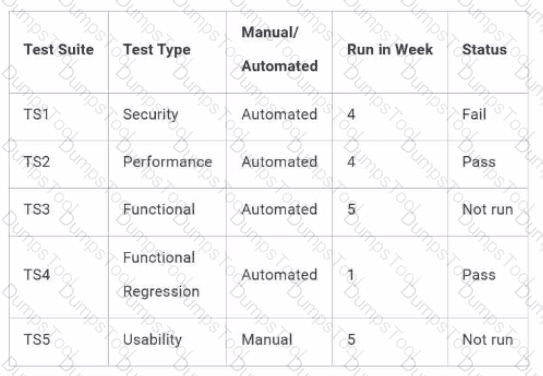
Review this report against the organisational Test Strategy, what is the status of the Test Strategy objectives? SELECT ONE OPTION
A car rental company offers discounts to its customers based on a number of factors, including booking history, length of membership and type of car being booked. An update to the rental application is under test, with test cases written that specifically address a documented product risk covering discount calculation. Although the risk impact was analysed as high, the likelihood was given as low, as there had been no known changes to the calculation rules. However, during test execution some discount calculations were incorrect and investigation showed that code changes had been made that impacted the discount algorithms. As a result, the likelihood was increased to high by the risk management team.
Which would be the BEST measure to take to respond to the current situation?
What is the primary use for the traceability information regarding the relationship between test results and test conditions during test execution? [2]
Which combination matches the four cost of quality categories with a CORRECT example of its category?
As the Test Manager working for a company developing safety related software for defence equipment, you have been asked to consider how you can track test progress and report on the following:
1) Test cases adequately cover all requirements
2) Issues relating to safety critical vulnerabilities are being addressed in priority order
3) How much of the developed system has been exercised through testing What tools would help to achieve this?
SELECT ONE OPTION
Which of the following describes the Failure Mode and Effect Analysis (FMEA) risk analysis technique? SELECT ONE OPTION
You have just conducted a skills assessment for your team. You decided to rate everyone from 1 to 5 in the skill areas as follows:
5 = expert
4 = proficient
3 = can use this skill effectively but will need some assistance
2 = interested in learning this skill but has only minimal knowledge
1 = not interested in learning this skill
Given these values, you have rated your team as shown in the table below for the designated skill areas:
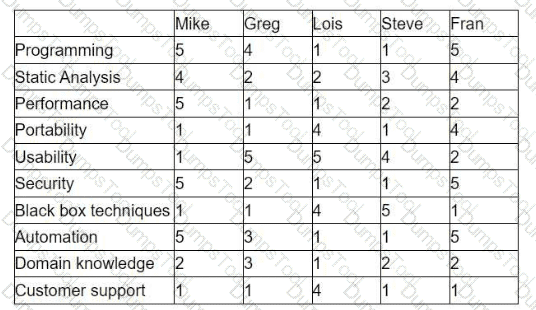
You will be starting to test a new product that is an upgrade from one of your existing end user products. Your testing will include white box,
performance, security, usability, and black box. You also have a goal to automate 100% of the smoke test and 50% of the regression tests by the end of the release.
Your team willingly shares knowledge and conducts regular lunch time cross-training sessions.
Your manager wants to know if you would like to bring in someone to help train your team in preparation for this project. In which area could
you best utilize this help? [3]
Which ONE of the following is considered to be the LEAST independent form of testing for anorganisation? SELECT ONE OPTION
You are Test Manager for a project which is in the Test Implementation stage for the first planned iteration, creation of the initial Test Cases and required test data is progressing well.
The Test Strategy documents the Stakeholders view that small teams should collaborate together to create and test functionality which is to be released in iterations, with each release building on the success of the last.
Stakeholders are willing to accept the risks of a partly working system in the early stages. Delivery of working functionality (particularly around interfaces to third party systems and performance of back end databases) is the priority for the early releases.
Which of the following test types would you select for this first planned iteration, in order to meet Stakeholders expectations?
a) Usability testing
b) Structural testing
c) Functional testing of process flows
d) Performance testing
e) Business process testing
f) Component integration testing
You are Test Manager for a project which is in the Test Implementation stage for the first planned iteration, creation of the initial Test Cases and required test data is progressing well.
The Test Strategy documents the Stakeholders view that small teams should collaborate together to create and test functionality which is to be released in iterations, with each release building on the success of the last.
Stakeholders are willing to accept the risks of a partly working system in the early stages. Delivery of working functionality (particularly around interfaces to third party systems and performance of back end databases) is the priority for the early releases.
Which of the following test types would you select for this first planned iteration, in order to meet Stakeholders expectations?
a) Usability testing
b) Structural testing
c) Functional testing of process flows
d) Performance testing
e) Business process testing
f) Component integration testing
You are assigned to test a new application being developed in-house and you have designed a set of test cases to specifically address key product risks. You will issue daily reports summarising how these test cases are progressing during test execution. When considering the audience for these reports, in which stakeholder matrix quadrant would the product's users reside?
You are Test Manager working on a project which is improving the user interface for its call centre staff handling customer enquiries. The project has completed UAT for the first iteration; however a large number of defects were raised by call centre staff seconded to help with the User Acceptance testing.
The defects described the user interface as not being intuitive enough with a poor 'help' facility. A user representative spent a week working with developers and system testers to explain the issues, which were subsequently agreed to have resulted from poorly specified usability requirements.
The requirements were defined separately for each iteration and have been formally reviewed by business analysts, developers and the IT director.
The user representative was also able to answer a number of other questions that the system test team had regarding call centre workflows, which improved their domain knowledge.
You have been asked to conduct a project retrospective and recommend improvements for the next iteration which introduces further user interface changes. Which of the following would be the MOST effective improvement for the next iteration?
SCENARIO 3
You are the Test Manager for a software house called "MakeMyApp" that specialise in mobile phone applications, agile techniques are used for all software development projects.
A new project is underway to develop enhancements to a 'photo sharing' application, known as 'PictureFriend'. There are two types of user account available -Premium Users and Guest Users. Guest users only have limited functionality available. The enhanced features to PictureFriend are:
• Feature 1: Guest Users can share photos with other Guest Users and Premium Users;
• Feature 2: Premium Users can edit pictures before posting to their account;
• Feature 3: Premium Users can create '3D-effect' photographs
The requirements for each feature will be broken down into a number of User Stories with acceptance criteria created for each of them. User Stories are planned and delivered in 2-week 'Sprints'. The project will have 3 sprints.
Refer to SCENARIO 3
You have been asked to select an appropriate review type and review remit for the project.
Which of the following is the BEST review type and remit for this project?
SELECT ONE OPTION
You are managing the test team that is testing a new mobile application that provides a "step-by-step' hiking guide Your risk assessment resulted in the following table:
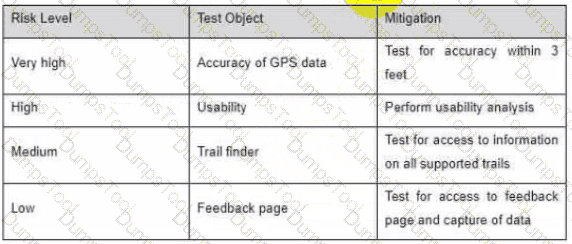
Your team has clone the depth and breadth testing for the GPS accuracy and usability features but when the product was given to beta testers there were some issues Despite the users reporting the app was easy to use at least one user walked off the edge of a cliff and another one ended up in a river. Your team has confirmed that the functionality is working correctly. and the GPS information is accurate.
What other area of testing should you now prioritize?
It the lest manager must repeatedly step in to resolve conflicts within the team what phase is the team in and what competencies are required from the test manager?
Which of the following defect statistics will provide input to be used for improvement in the defect reporting process?
Your team has been assigned to lest a new product that is tightly integrated with existing systems The integrations include data transfers and transformations You have access to the architectural design documents and the integration specifications and some of your testers are former developers.
Given this information, what is the most appropriate test approach?
Your team has been working on an Agile project for two months. There is a retrospective at the endof each sprint One of the data items reviewed is how many defects are being caught by users rather than by testers. The test team is being blamed for these escapes
What do you need to do to make these sessions more productive?
It is now the final day of the planned user acceptance test period and you are preparing the test completion report. Some defects have not been fixed and some tests have not been run; due to both these factors the exit criteria have not been met.
Which two of the following metrics will be most useful in helping the stakeholders to decide whether to allow the system into production?
Which TWO of the following metrics will be MOST useful in helping the stakeholders to decide whether to allow the system into acceptance testing?
Breakdown of all risks by status (closed / not fully tested / one or more tests failed)
Breakdown by test priority of test execution status (passed / failed / not run)
Breakdown of outstanding risks by risk level and status (not fully tested / one or more tests failed / both)
Breakdown of unresolved defects by severity and status
Breakdown of unresolved defects by Risk Id/s that is/are affected by them
You have been assigned t o a project that has a very tight schedule. In fact, given your first analysis you do not think the planned test execution can be completed within the schedule There is no time allowed for defect fixing or for repeating tests. Regression testing has been left out of the planning entirely There is no time to develop test automation. The team has agreed that this Is not the way to run a project, yet they are stuck with the current schedule
Given this information what is the best way to proceed with the testing to try to meet the deadline with the best outcome1?
Risks have been identified for a project and they have been analysed using a quantitative method, with the following results for probability and impact.

Which risk should the System Testing focus on mitigating first?
SELECT ONE OPTION
You are managing the testing for a bank card project. The testing was scheduled to take 10 weeks but by the time the software was developed only six weeks were available for testing Knowing there were a lot of risks with the software your team started testing activities early by overseeing code reviews, defining acceptance criteria by working with the users and by doing all lest creation prior to the code arriving
You are now three days away from the go-live date Your testing has mitigated all the high and medium risk items leaving only the low-risk elements unmitigated by testing You estimate it will take two weeks to manually test the low-risk elements At this point what should you do?
Your team has been given the following test objective Ensure that the users are happier with this version than they were with the last version?
What is wrong with the way this is defined?
Your manager has decided that your team of manual testers should all become test automation engineers Your team is much stronger in analysis than In technical testing so you are concerned about their ability to adapt. What tool capabilities could help with this transition?
There is a debate in your organization about who can close a defect report The developers think they should be able to reject and close defects without any further steps The testers are not happy with this approach as they are afraid the rejections may go undetected and the developers may close something without understanding the real problem
How can this problem be rectified7
You are looking to Improve the efficiency of testing. The developers have been claiming that the majority of defect reports they receive are invalid either due to the test environment or because the tester did not follow the right steps In a standard defect management process where should you look for more information about these invalid defects?
You have assembled the following cost of quality numbers 200 defects were found prior to release and 100 were found after.
Given this information what is the total cost of quality for this project?
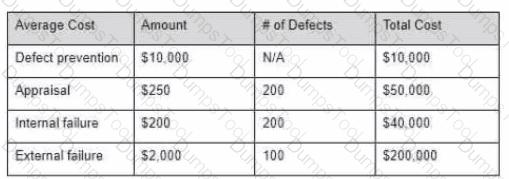
Which of the following is the proper order for the stages of a tool lifecycle?
Your team has been assigned to a new project You have a mix of manual testers and automation engineers but everyone is currently doing manual testing. The development learn has alreadydecided to use DevOps as its approach but they have never used it before and are happy to take your input Unfortunately, about 50% of the development is completed already In the testing your team is doing they are finding that about 40% of the defects they catch are actually regressions caused by other changes
Given this information what should you do to help mitigate risk'?
At what testing level do the test management activities Include coordinating with end users7
Your team has decided that they will build their own test management tool This will allow them to link the requirements and test cases together providing full traceability It will also allow them to create fully customized reporting and color-coded dashboards They have estimated the time required to create the new tool and the cost These fit within the project schedule and budget
What other consideration should be taken before this decision is made?
You are a new lest manager in an organization You have been asked to assess the defect process to determine if there are any efficiency improvements that could be made that would reduce the cost of quality You have started digging through the defect Information What information would be most helpful for this investigation?
You are working on a project where the business part of the organization works traditionally with defined requirements, but the development team follows an Agile model Neither team plans to change their approach What is the proper name for this type of project approach''
You are working for an outsource testing company You have a client that will only consider candidates that are highly skilled with Salesforce. regardless of the number of years they have spent testing similar products You have looked through your skills matrix and you have no one with the right type of experience for this project.
What competence area is your team lacking?
Your team has been assigned to test a loyalty card program for a supermarket chain. Because this is a highly competitive market significant investment has been made to determine the shortcomings of the products offered by competitors While the feature sets are mostly the same, there is a wide variance In usability and performance and the users perceptions of these quality characteristics
Given only this information what test approach would be most appropriate?
You are working In an environment that is continually pushing process improvements down to the lest team You are skeptical that any of these have actually accomplished any improvement In fact you know that some of the changes have actually impaired progress
Given this information what step of the IDEAL model is missing?
Which of the Mowing should be used to understand the context of testing within an organization?
You tend to be conservative in your project estimations because you know how many things can go wrong and extend the schedule. You manager is not happy with your estimates and thinks you are being too negative with your numbers and not trying hard enough Which estimation method should you use to provide your manager with a positive' number while still also providing the number you think is more realistic?
You have been asked to make a recommendation on deployment readiness on the software your team has been testing.You have the following metrics:
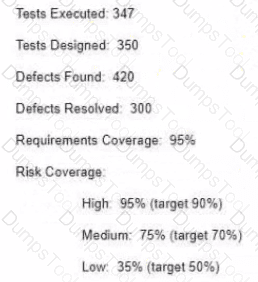
Given this information what is a critical metric you are missing?
Which of the following best describes the appraisal costs in the cost of quality'